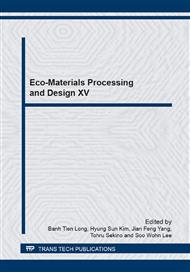p.191
p.195
p.199
p.203
p.209
p.213
p.217
p.221
p.225
The Photocatalytic Degradation of Methomyl over TiO2 Nanopowder Prepared by the Low Temperature Solvothermal Route
Abstract:
Titanium dioxide (TiO2) nanopowder was prepared by the low temperature solvothermal route with starting chemicals containing titanium isopropoxide, ammonium hydroxide, nitric acid and ethanol in a PTFE–lined autoclave. The final pH of the mixed solution was 1 and treated at 100 °C for 2–6 h. The white precipitated was filtered and dried in an oven at 80 °C for 24 h. The phase transition was characterized by X–ray diffractometer (XRD). Single phase anatase structure was obtained without calcination step. The morphology and particle size of TiO2 nanopowder was investigated by scanning electron microscope (SEM). The average of TiO2 nanopowder size was 80–120 nm. The average particle size increased with temperature and time increased. The photocatalytic degradation of methomyl in natural water was studied by high performance liquid chromatograph (HPLC). The percentage of methomyl was decreased in the presence of 34, 23 and 24 over TiO2 nanopowder prepared by the low temperature solvothermal route at 100 °C for 2, 4 and 6 h, respectively.
Info:
Periodical:
Pages:
209-212
Citation:
Online since:
October 2014
Price:
Сopyright:
© 2015 Trans Tech Publications Ltd. All Rights Reserved
Share:
Citation:


